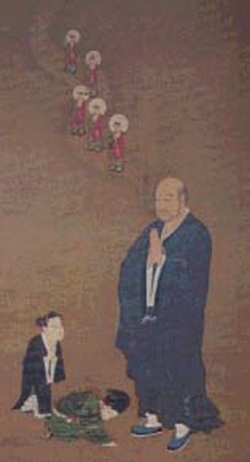Difference between revisions of "Shan-tao"
| Line 1: | Line 1: | ||
[[File:Shantao.jpeg|thumb|250px|]] | [[File:Shantao.jpeg|thumb|250px|]] | ||
<poem> | <poem> | ||
| − | + | [[Shan-tao]] (Jp. [[Zendo]]) [613-681] | |
| − | + | [[Shan-tao]] is the {{Wiki|Chinese}} [[patriarch]] on whom [[Honen]] relied for most of his [[teaching]] in the [[Senchakushu]]. In 641, he visited [[Tao-ch'o]] at [[Hsuan-chung-ssu]] [[temple]] and [[heard]] him give a lecture on the [[Meditation Sutra]] ([[Kuan wu-liang-shou ching]]), which greatly deepened his [[faith]] in the [[Pure Land]]. Thereafter he went to [[Ch'ang-an]] where he disseminated the practice of calling upon the [[name]] of [[Amida Buddha]]. [[Shan-tao]] wrote five works on [[Pure Land]] teachings: the [[Kuan wu-liang-shou ching shu]] (Commentary on the [[Meditation Sutra]]), the [[Kuan-nien-fa-men]] ([[Dharma Gateway of Contemplation]]), the [[Wang-sheng-li-tsan]] ([[Hymns in Praise of [[Birth]]), the [[Fa-shih-tsan]] ([[Liturgical Hymns]]), and the [[Pan-chou-tsan]] ([[Hymns for Samadhi Wherein All the Buddhas are Present]]), which, except for the last one, are widely cited in the [[Senchakushu]] by [[Honen]]. [[Shan-tao]] is generally credited for popularizing the [[nembutsu]] as the reciting of [[Amida's]] [[name]] rather than the [[visualization]] of him in his [[Pure Land]]. | |
| + | |||
| + | [[Shan-tao]] (613-681) was the fifth of the seven [[patriarchs]] in the [[tradition]] of [[Jodoshinshu]] and also the third of the five [[Pure Land]] [[masters]] in {{Wiki|China}}. His contribution to the development of [[Pure Land Buddhism]] was so great and far-reaching that it would be impossible to speak of the growth and spread of this [[form]] of [[Buddhism in China]] and its neighboring countries, including {{Wiki|Japan}}, without reference to him. | ||
| + | |||
| + | [[Shan-tao's]] [[Liturgy for Birth]] - [[Ojoraisan]] - is a collection of passages and hymns from [[Pure Land]] [[sutras]] and discourses, arranged in six [[sections]] according to the six different times of the day. This is a [[formula]] of daily devotional practice. | ||
| + | |||
| + | Each section consists of a quotation from a [[Wikipedia:canonical|canonical]] source, words of praise of [[Amida's]] {{Wiki|virtues}}, a number of worshipful {{Wiki|prostrations}}, and {{Wiki|confession}} of [[Shan-tao's]] own [[karmic]] {{Wiki|evil}}. | ||
</poem> | </poem> | ||
{{R}} | {{R}} | ||
Revision as of 08:14, 3 October 2013
Shan-tao (Jp. Zendo) [613-681]
Shan-tao is the Chinese patriarch on whom Honen relied for most of his teaching in the Senchakushu. In 641, he visited Tao-ch'o at Hsuan-chung-ssu temple and heard him give a lecture on the Meditation Sutra (Kuan wu-liang-shou ching), which greatly deepened his faith in the Pure Land. Thereafter he went to Ch'ang-an where he disseminated the practice of calling upon the name of Amida Buddha. Shan-tao wrote five works on Pure Land teachings: the Kuan wu-liang-shou ching shu (Commentary on the Meditation Sutra), the Kuan-nien-fa-men (Dharma Gateway of Contemplation), the Wang-sheng-li-tsan ([[Hymns in Praise of Birth), the Fa-shih-tsan (Liturgical Hymns), and the Pan-chou-tsan (Hymns for Samadhi Wherein All the Buddhas are Present), which, except for the last one, are widely cited in the Senchakushu by Honen. Shan-tao is generally credited for popularizing the nembutsu as the reciting of Amida's name rather than the visualization of him in his Pure Land.
Shan-tao (613-681) was the fifth of the seven patriarchs in the tradition of Jodoshinshu and also the third of the five Pure Land masters in China. His contribution to the development of Pure Land Buddhism was so great and far-reaching that it would be impossible to speak of the growth and spread of this form of Buddhism in China and its neighboring countries, including Japan, without reference to him.
Shan-tao's Liturgy for Birth - Ojoraisan - is a collection of passages and hymns from Pure Land sutras and discourses, arranged in six sections according to the six different times of the day. This is a formula of daily devotional practice.
Each section consists of a quotation from a canonical source, words of praise of Amida's virtues, a number of worshipful prostrations, and confession of Shan-tao's own karmic evil.
